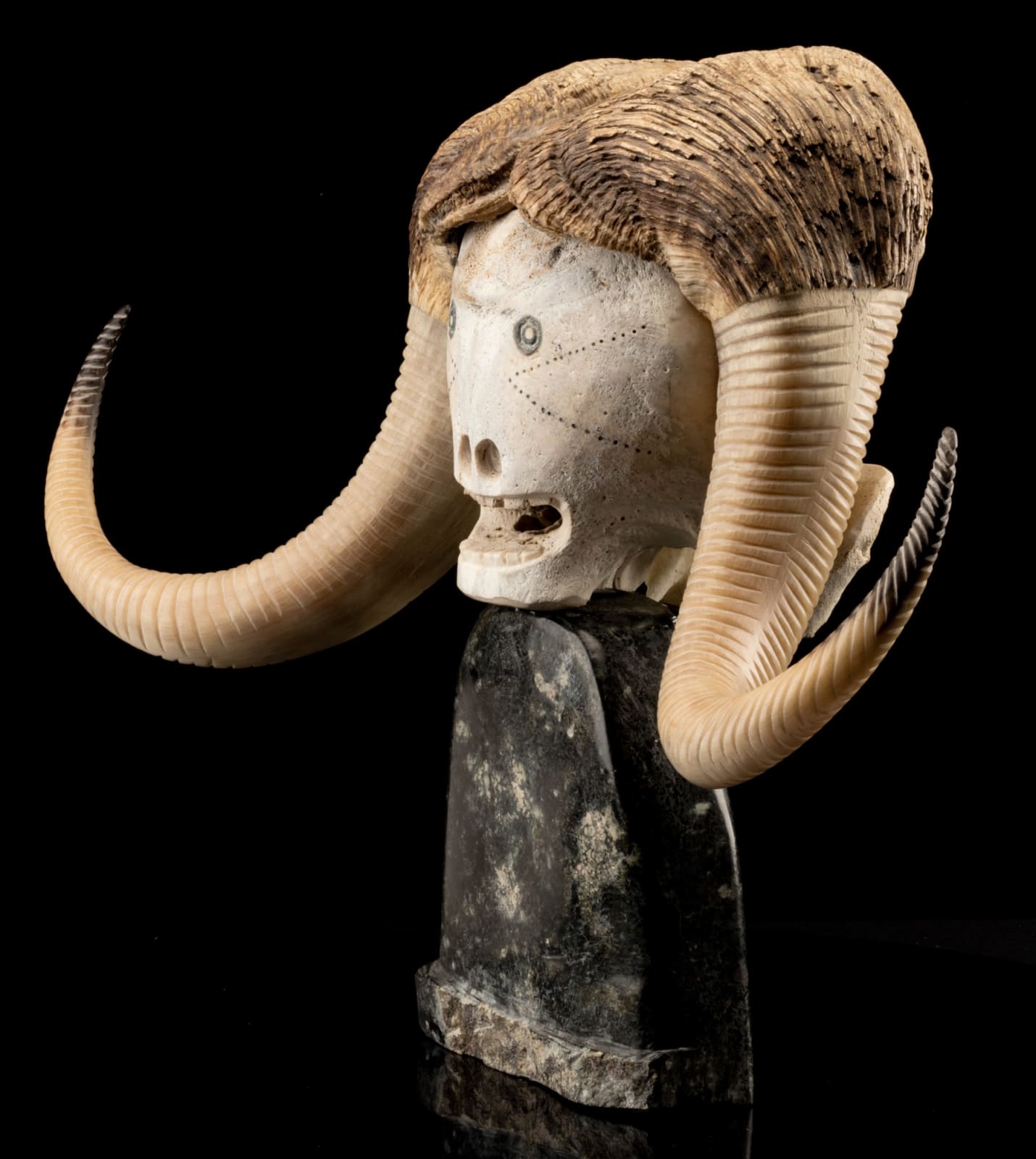-
Artworks
JUDAS ULLULAQ (1937-1999), UQSUQTUUQ (GJOA HAVEN)
Muskox Shaman, 1988muskox horns and skull, stone, string, and black inlay, 17.5 x 24.5 x 9.5 in (44.5 x 62.2 x 24.1 cm)
signed, "ᐅᓗᓚ".LOT 116
ESTIMATE: $20,000 — $30,000
PRICE REALIZED: $18,300.00Further images
Judas Ullulaq famously carved in both stone and whale bone to produce sculptures with a variety of themes and subjects. Muskoxen were favourite subjects: as single figures, in hunting scenes...Judas Ullulaq famously carved in both stone and whale bone to produce sculptures with a variety of themes and subjects. Muskoxen were favourite subjects: as single figures, in hunting scenes (see Lot 123), and in shamanic imagery. Muskox horn was also one of his favoured materials; Ullulaq used it as inlay or to fashion weapons and implements, but he also incorporated single horns or even full sets of two in large-scale compositions. [1] In a handful of works the artist invented a particularly daring compositional format in which he made use of a full set of horns still attached to part of the animal’s skull. A fine example of this is the marvelous Muskox Shaman with Spirit Helper from c. 1988-90, sold at auction by First Arts (13 July 2021, Lot 24).
In the present Muskox Shaman, Ullulaq takes his inventiveness to a new level by manipulating a set of old horns and skull (which he would have found on the land). By reorienting the position of the skull itself and re-attaching the horns, he has managed to free up a flat section on which to create the mesmerizing, skull-like face of a tattooed shaman. Ullulaq has meticulously carved ridged rings into the horns, transforming them into braids. These, together with the facial tattoos, identify this formidable shaman as a woman.
Ullulaq’s love of texture and contrast is well-known and is on full display here. We love the way that both the colour and texture of the carved horn ridges contrast with the natural striations at the base of the horns (the “boss” – which itself looks like hair). The face brings a further change in colour and texture. The stone base (which looks dress-like) turns the sculpture almost into a full female figure. And finally, the back of the head – intentionally, we are certain – presents another, seriously spooky face.
Muskox Shaman is one of Ullulaq’s most brilliant inventions – one that manages to be incredibly eerie and genuinely lovely at the same time. It’s a powerful, stirring work of art. Astounding.
1. See the section on Judas Ullulaq in Darlene Coward Wight, Art & Expression of the Netsilik, (Winnipeg Art Gallery, 2000), pp. 152-171 – in particular, cats. 148, 154, 157.
References: For a closely related work by Ullulaq see First Arts, 13 July 2021, Lot 24. For a wider idea of how muskoxen appear in Ullulaq’s art see First Arts, 12 July 2020, Lot 1; 5 December 2022, Lots 59 and 155; and First Arts, 4 December 2023, Lot 59; see also Ingo Hessel, Arctic Spirit: Inuit Art from the Albrecht Collection at the Heard Museum, (Vancouver: Douglas & McIntyre / Phoenix: Heard Museum, 2006), cats. 84, 85. For a discussion of Ullulaq’s life and work, and illustrations of twenty sculptures see Darlene Coward Wight, Art & Expression of the Netsilik, (Winnipeg: Winnipeg Art Gallery, 2000) pp. 152-171.Provenance
Images Art Gallery, Toronto, ON;
Acquired from the above by the present Private Collection, Toronto.
Publications
Harold Seidelman & James Turner, The Inuit Imagination: Arctic Myth and Sculpture, (Vancouver: Douglas & McIntyre Ltd., 1993), fig. 24, p. 59.
Join our mailing list
* denotes required fields
We will process the personal data you have supplied in accordance with our privacy policy (available on request). You can unsubscribe or change your preferences at any time by clicking the link in our emails.










